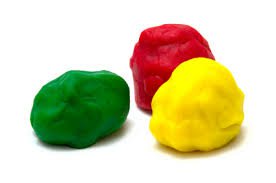Your Cart is Empty

Occupational therapy (OT) practitioners can address many of the common concerns parents have for a child who has autism or sensory processing disorder. The goal of occupational therapy is to promote the highest level of functioning in daily life.
Occupational therapists must be creative when developing activities in order to address underlying issues and keep the child interested and engaged.
To help support the child outside of OT sessions, you can plan activities at home that promote the development of many important life skills!

Sensory bins are a great way to promote a variety of skills. For example, many children with autism or SPD are sensitive to certain textures.
A sensory bin is a playful way to introduce them to a variety of tactile (touch) experiences! This activity can also promote visual perception skills, language skills, and fine-motor skills.
To make a sensory bin, simply gather common household items and place in a plastic container. Items might include cotton balls, uncooked rice or beans, popcorn, cut up paper, coins.
It is important to be aware of your child’s unique sensory preferences so they are not overwhelmed, but can also develop important skills. It is also very important not to leave your child alone while playing with items that can be a choking hazard.
Swings are a great way to incorporate calming, organizing and sensory input.

For this activity, have your child lay on their stomach on a swing. The Harkla compression swing a great option! Then, place about 6-7 empty containers around the swing, giving enough distance so the child has to move to reach the containers.
Give the child several small balls or bean bags and explain that their goal is to put one ball or bean bag in each container. This activity promotes body awareness, visual perception skills, coordination, and muscle strength.
To learn more about the wonderful benefits of sensory swings, check out this article!
Children with autism typically have difficulty with social skills. One of the main skills commonly addressed in Occupational Therapy is perspective-taking. Often, it is difficult for them to understand what others might be feeling or thinking.
For this activity, find out what the child’s favorite cartoon character is. You can then look up video clips (Youtube is a great resource) from the show. Use this as a motivating way to talk about how the characters might be feeling, what they are doing, or what they might be thinking.
This is an engaging activity and can be a helpful way to introduce emotions and different perspectives.

The activity of making playdough is not only enjoyable for kids, but it also addresses numerous important skills.
To make the dough, combine 1 cup of fine salt and 1 cup of flour in a bowl and mix. Once it is mixed well, add ½ cup water and knead and form the dough until it is smooth.
Skills addressed in this activity include:
Children with sensory processing difficulties often struggle with oral motor concerns, such as coordinating movements of the mouth or accepting different textures. One way to assist with desensitizing this area is to have a straw race.
For this activity, gather a large plastic container and fill it with water. Then, place two lightweight objects, such as a paper cup in the water. You and your child then use straws to try and blow the paper cups to the other side. Whoever reaches the other side first, wins!
If your child is not ready for competitive games, you can modify the activity and have the child blow the cup as fast as he can. Let him know how many seconds it took. This activity also addresses vision and coordination skills, besides being a great oral exercise.
Visual aids are a tool that most children with autism respond very well to. Making a coping skills flip book provides a visual aid for children to use when they are in distress.
Work with your child to come up with 5-7 things they can do when they become frustrated or need a break. Then, take pictures of your child engaging in the activities they identified. Print out these photos, laminate them, and secure with a loop ring. Some examples of coping skills might be reading a book, using a stress ball, going to a quiet space, or talking to an adult.
You can find more great ideas here!
Start by engaging your child in an activity that encourages repetition, such as throwing a ball back and forth to one another or tossing bean bags back and forth. Repetitive activities activate the part of the brain involved in regulating our emotions. Starting each session with this type of activity will help your child feel calm, organized, and ready to work.
Simon Says is a classic game children typically learn in school. It can be a great activity to try at home, too! There are many different skills that can be addressed and sensory diet activities that can be incorporated.
For example, crawling through a lycra tunnel (deep pressure) and then jumping five times (body awareness). To add a social skill component, your child can also have a turn directing you! This encourages perspective-taking and creativity.

Typically, children with autism have trouble identifying different levels of frustration or distress. They can become over-stimulated or frustrated without much warning.
An emotion thermometer can be a helpful visual tool to assist with this. Draw or trace a thermometer on a standard piece of paper and cut it out. Then, work with your child to identify 3-5 levels they experience. For example, a 1 might be completely calm and a 3 might be starting to feel frustrated.
Let your child color or decorate their thermometer for added motivation, fine motor skills, and visual perception skills.
For other strategies to help calm meltdowns, click here!
For this activity, you’ll need a paper plate, four popsicle sticks, and cutouts of different eyes, noses, mouths, and ears. Work with your child to make a person. Let them know they are able to choose the way the face looks by choosing certain eyes, nose, ears, and mouth.
This activity works on body awareness and orientation, vision skills, and can be a way to discuss emotions. Have your child identify how their person might be feeling, depending upon which type of facial features they chose.
Creativity and skill-building are two of the most crucial elements of an occupational therapy session. There are so many different ways to address the necessary skills, but it is always most important to consider each child’s unique needs and interests.
Hopefully, the activities described above will provide some inspiration when planning occupational therapy activities to do at home!
Thanks Shea Brogren, the above OT concepts and ways are unqiue and has helped us a lot, many thanks
thankyou, its helpful
Hey Neelratan,
Thanks for your feedback! We’re glad you found the article helpful.
Take care!
Nicole
Harkla Happiness Ninja
These activities are helpful for children with developmental delay
Comments will be approved before showing up.


Amar
October 31, 2022
Really practical activites to follow. Thank you for sharing.